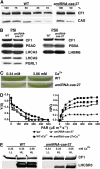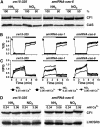The chloroplast calcium sensor CAS is required for photoacclimation in Chlamydomonas reinhardtii
- PMID: 21856795
- PMCID: PMC3180803
- DOI: 10.1105/tpc.111.087973
The chloroplast calcium sensor CAS is required for photoacclimation in Chlamydomonas reinhardtii
Abstract
The plant-specific calcium binding protein CAS (calcium sensor) has been localized in chloroplast thylakoid membranes of vascular plants and green algae. To elucidate the function of CAS in Chlamydomonas reinhardtii, we generated and analyzed eight independent CAS knockdown C. reinhardtii lines (cas-kd). Upon transfer to high-light (HL) growth conditions, cas-kd lines were unable to properly induce the expression of LHCSR3 protein that is crucial for nonphotochemical quenching. Prolonged exposure to HL revealed a severe light sensitivity of cas-kd lines and caused diminished activity and recovery of photosystem II (PSII). Remarkably, the induction of LHCSR3, the growth of cas-kd lines under HL, and the performance of PSII were fully rescued by increasing the calcium concentration in the growth media. Moreover, perturbing cellular Ca(2+) homeostasis by application of the calmodulin antagonist W7 or the G-protein activator mastoparan impaired the induction of LHCSR3 expression in a concentration-dependent manner. Our findings demonstrate that CAS and Ca(2+) are critically involved in the regulation of the HL response and particularly in the control of LHCSR3 expression.
Figures









Similar articles
-
PHOTOSYSTEM II SUBUNIT R is required for efficient binding of LIGHT-HARVESTING COMPLEX STRESS-RELATED PROTEIN3 to photosystem II-light-harvesting supercomplexes in Chlamydomonas reinhardtii.Plant Physiol. 2015 Apr;167(4):1566-78. doi: 10.1104/pp.15.00094. Epub 2015 Feb 19. Plant Physiol. 2015. PMID: 25699588 Free PMC article.
-
Energy-dissipative supercomplex of photosystem II associated with LHCSR3 in Chlamydomonas reinhardtii.Proc Natl Acad Sci U S A. 2013 Jun 11;110(24):10016-21. doi: 10.1073/pnas.1222606110. Epub 2013 May 28. Proc Natl Acad Sci U S A. 2013. PMID: 23716695 Free PMC article.
-
Transcriptional regulation of the stress-responsive light harvesting complex genes in Chlamydomonas reinhardtii.Plant Cell Physiol. 2014 Jul;55(7):1304-10. doi: 10.1093/pcp/pcu068. Epub 2014 May 20. Plant Cell Physiol. 2014. PMID: 24850838
-
Environmentally modulated phosphorylation and dynamics of proteins in photosynthetic membranes.Biochim Biophys Acta. 2007 Jun;1767(6):449-57. doi: 10.1016/j.bbabio.2006.11.007. Epub 2006 Nov 15. Biochim Biophys Acta. 2007. PMID: 17184728 Review.
-
Dynamic regulation of photosynthesis in Chlamydomonas reinhardtii.Plant J. 2015 May;82(3):413-428. doi: 10.1111/tpj.12805. Epub 2015 Mar 17. Plant J. 2015. PMID: 25702778 Review.
Cited by
-
Increased biomass productivity in green algae by tuning non-photochemical quenching.Sci Rep. 2016 Feb 18;6:21339. doi: 10.1038/srep21339. Sci Rep. 2016. Retraction in: Sci Rep. 2019 Sep 06;9(1):13026. doi: 10.1038/s41598-019-48482-w. PMID: 26888481 Free PMC article. Retracted.
-
Recent advances in understanding photosynthesis.F1000Res. 2016 Dec 21;5:2890. doi: 10.12688/f1000research.9744.1. eCollection 2016. F1000Res. 2016. PMID: 28105322 Free PMC article. Review.
-
Regulation of the calcium-sensing receptor in both stomatal movement and photosynthetic electron transport is crucial for water use efficiency and drought tolerance in Arabidopsis.J Exp Bot. 2014 Jan;65(1):223-34. doi: 10.1093/jxb/ert362. Epub 2013 Nov 1. J Exp Bot. 2014. PMID: 24187420 Free PMC article.
-
Diatoms exhibit dynamic chloroplast calcium signals in response to high light and oxidative stress.Plant Physiol. 2024 Dec 23;197(1):kiae591. doi: 10.1093/plphys/kiae591. Plant Physiol. 2024. PMID: 39515781 Free PMC article.
-
Fluorescence lifetime analyses reveal how the high light-responsive protein LHCSR3 transforms PSII light-harvesting complexes into an energy-dissipative state.J Biol Chem. 2017 Nov 17;292(46):18951-18960. doi: 10.1074/jbc.M117.805192. Epub 2017 Sep 27. J Biol Chem. 2017. PMID: 28972177 Free PMC article.
References
-
- Allmer J., Naumann B., Markert C., Zhang M., Hippler M. (2006). Mass spectrometric genomic data mining: Novel insights into bioenergetic pathways in Chlamydomonas reinhardtii. Proteomics 6: 6207–6220 - PubMed
-
- Berridge M.J., Irvine R.F. (1989). Inositol phosphates and cell signalling. Nature 341: 197–205 - PubMed
-
- Bouché N., Scharlat A., Snedden W., Bouchez D., Fromm H. (2002). A novel family of calmodulin-binding transcription activators in multicellular organisms. J. Biol. Chem. 277: 21851–21861 - PubMed
Publication types
MeSH terms
Substances
LinkOut - more resources
Full Text Sources
Miscellaneous

